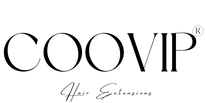¿Cuál es el tipo de extensiones de cabello más saludable? Guía profesional para estilistas
Las extensiones pueden transformar por completo el look de una clienta, pero una de las primeras inquietudes en la consulta suele ser:
“¿Qué tipo de extensiones son las más saludables para mi cabello natural?”
Es una excelente pregunta, ya que no todos los métodos son iguales. Algunos son más ligeros y fáciles de mantener, mientras que otros pueden presentar más riesgos si no se colocan o cuidan adecuadamente. La opción más saludable depende del tipo de cabello de la clienta, su estilo de vida y sus objetivos a largo plazo.
Vamos a desglosarlo.
¿Qué entendemos por 'más saludable'?

Cuando hablamos de las extensiones de cabello 'más saludables', realmente nos referimos a:
-
¿Este método protegerá el cabello natural de roturas o tensión?
-
¿Permite que el cuero cabelludo respire?
-
¿Se pueden retirar las extensiones sin dañar el cabello?
-
¿Es un método de baja tensión y ligero?
La extensión más saludable es aquella que embellece el cabello sin comprometer su integridad.
Métodos de extensiones más saludables
1. Extensiones tipo halo
Opción removible sin daños.
-
Una sola cortina de cabello sujeta a un hilo transparente se coloca cómodamente en la coronilla.
-
Sin cuentas, pegamento ni adhesivos.
-
Se aplica en menos de un minuto y se retira igual de rápido.
¿Por qué son saludables? No genera tensión ni se adhiere al cabello natural. Perfecto para clientas con cabello frágil o con poco volumen.
2. Extensiones de cinta adhesiva
Ligero y con distribución uniforme.
-
Tiras adhesivas planas 'envuelven' pequeñas secciones de cabello natural.
-
Prácticamente invisibles si se aplican correctamente.
-
Reutilizables hasta 2–3 veces.
¿Por qué son saludables? La cinta ancha distribuye el peso de manera uniforme, minimizando la tensión. Excelente para clientas de cabello fino.
3. Cortinas cosidas a mano o tipo Genius
Seguras, reutilizables y flexibles.
-
Se instalan fila por fila con cuentas y luego se cosen.
-
Las cortinas 'Genius' son ultrafinas, se pueden cortar y no causan irritación.
¿Por qué son saludables? Si se aplican correctamente, la tensión se distribuye uniformemente en las filas. Menos riesgo de rotura en comparación con las cortinas gruesas hechas a máquina.
4. Extensiones I-Tip (microcuentas)
Reutilizables y sin pegamento.
-
Mechones individuales sujetos al cabello natural con cuentas forradas de silicona.
-
No requieren calor ni pegamento.
¿Por qué son saludables? Sin adhesivos químicos y el cabello puede reutilizarse. El riesgo solo ocurre si las cuentas se colocan demasiado apretadas.
5. Extensiones de clip (uso ocasional)
Ideales para ocasiones especiales, no para uso diario.
-
Removibles, versátiles y sin daño si se usan con moderación.
-
Las versiones ligeras (clips invisibles) son ideales para cabello fino.
¿Por qué son saludables? No generan tensión permanente, salvo que se usen a diario, lo que puede provocar estrés en las zonas de los clips.
Métodos que debes evitar si la salud capilar es prioridad
-
Cortinas pesadas hechas a máquina en cabello fino → puede causar tensión en el cuero cabelludo.
-
Uniones de keratina de baja calidad → si el adhesivo no es de alta calidad, puede romper o debilitar el cabello natural.
-
Cabello sintético de baja calidad → se enredan fácilmente y tiran del cabello natural.
Consejos profesionales para mantener sanas las extensiones
-
Consulta cuidadosamente: Elige el método según la densidad del cabello, el estilo de vida y los objetivos.
-
Utiliza cabello Remy de alta calidad: El cabello alineado a la cutícula reduce los enredos y la fricción.
-
Mezcla correctamente la densidad: Nunca sobrecargues las raíces frágiles con demasiado peso.
-
Programa los retoques: 6–8 semanas para cintas/cortinas, 2–3 meses para I-tips.
-
Educa a los clientes: El método más saludable aún requiere hábitos adecuados de cepillado, lavado y descanso.
Un Apunte: Cabello Saludable = Clientes Felices
Para muchos clientes, 'saludable' significa más que evitar daños. Implica extensiones que sean cómodas, luzcan naturales y no les generen preocupación por su propio cabello. Cuando los clientes confían en la seguridad de sus extensiones, las llevan con confianza—y esa tranquilidad emocional es tan importante como la salud física del cabello.
Preguntas Frecuentes Sobre las Extensiones Más Saludables
1. ¿Cuál es el tipo de extensión más saludable?
Extensiones halo—no se adhieren al cabello natural en absoluto.
2. ¿Las extensiones con cinta dañan el cabello?
No, si se aplican y retiran profesionalmente. Son uno de los métodos permanentes más seguros para cabello fino.
3. ¿Las cortinas provocan pérdida de cabello?
No, si se instalan correctamente. Las cortinas cosidas a mano o 'genius' distribuyen la tensión de manera uniforme, manteniendo el cabello protegido.
4. ¿Las extensiones de clip son saludables para uso diario?
No—son más saludables cuando se usan de forma ocasional. El uso diario puede tensar las raíces.
5. ¿Qué extensiones son mejores para cabello muy fino?
Extensiones halo o cintas invisibles, según el estilo de vida del cliente.
Conclusión: La extensión más saludable depende del cliente
Entonces, ¿cuál es el tipo de extensiones de cabello más saludable?
-
Para cero daños: Halo.
-
Para cabello fino que necesita volumen: Cintas invisibles.
-
Para clientes con cabello más grueso: Cortinas cosidas a mano o 'genius'.
-
Para reutilización flexible: I-tips.
-
Solo para eventos especiales: Extensiones de clip.
El método más saludable no es igual para todos—es aquel que protege el cabello natural y y cumple con los objetivos de estilo del cliente.
Por eso los estilistas confían en Cooviphair. Nuestras extensiones halo, cintas, I-tips y cortinas están hechas de 100% cabello humano Remy, obtenidas de manera ética, ligeras y diseñadas pensando en la salud capilar.
Contacta a Cooviphair hoy para equipar tu salón con extensiones que protejan el cabello natural, den confianza a tus clientes y ofrezcan resultados impecables







